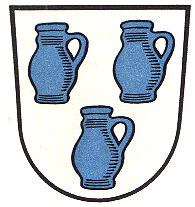Höhr-Grenzhausen: Difference between revisions
Jump to navigation
Jump to search
Knorrepoes (talk | contribs) m (Text replacement - "{{de}}" to "") |
Knorrepoes (talk | contribs) m (Text replacement - "{| class="wikitable"↵|+Official blazon↵|-↵|'''German'''↵| ↵|-↵|'''English''' ↵| {{blazon wanted}}↵|}" to "{| class="wikitable" |+Official blazon |- |'''German''' | blazon wanted |- |'''English''' | blazon wanted |}") |
||
| Line 13: | Line 13: | ||
|- | |- | ||
|'''German''' | |'''German''' | ||
| | | blazon wanted | ||
|- | |- | ||
|'''English''' | |'''English''' | ||
| | | blazon wanted | ||
|} | |} | ||
Revision as of 07:49, 6 April 2023
HÖHR-GRENZHAUSEN
State : Rheinland-Pfalz
District (Kreis) : Westerwaldkreis (until 1974 Unterwesterwaldkreis)
Additions : 1936 Höhr, Grenzau, Grenzhausen
| German | blazon wanted |
| English | blazon wanted |
Origin/meaning
The arms were adopted in 1936 after the merger of Höhr, Grenzhausen and Grenzau. The arms were based on a 17th century seal of the local pottery guild. The old seal also showed a complex escutcheon with the arms of Trier, Neuwied and Isenburg-Grenzau, the historical territories to which the area belonged. As these arms were too complicated the escutcheon was removed and the arms were officially granted in 1950. As pottery has been of great importance for the local economy, the jars were an appropriate symbol.
Literature: Stadler, 1964-1971, 8 volumes.
